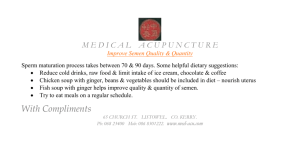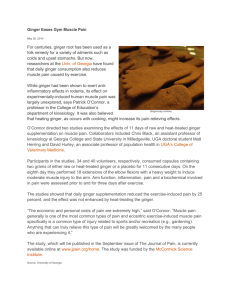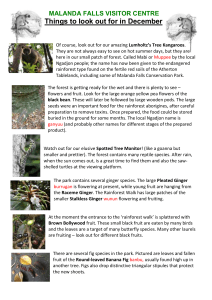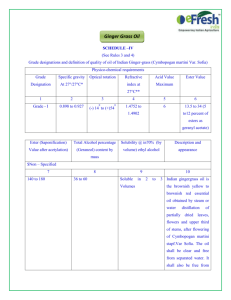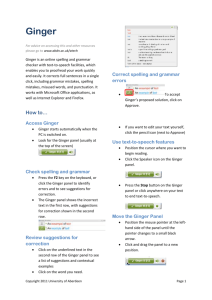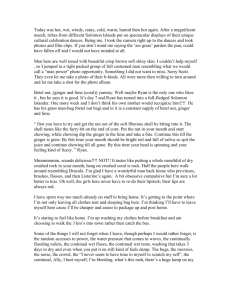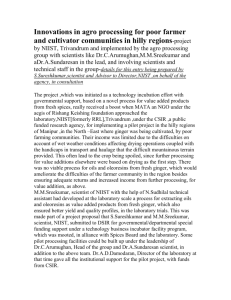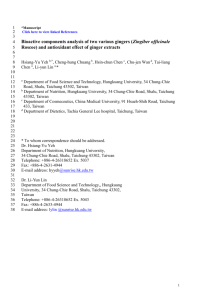Introduction
advertisement
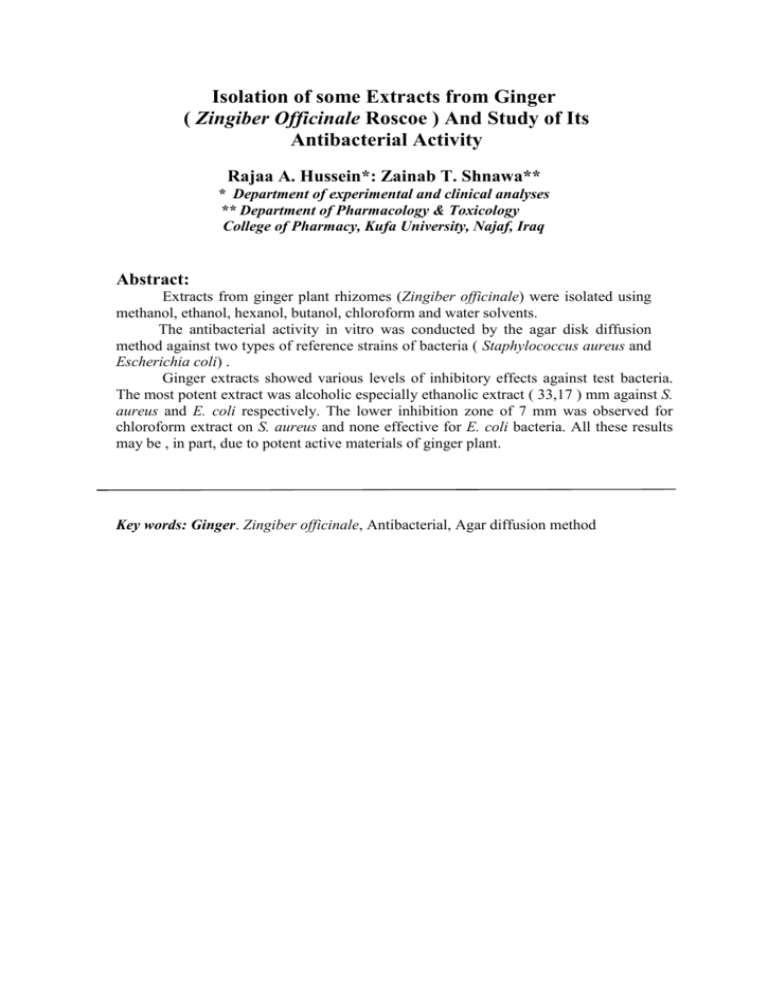
Isolation of some Extracts from Ginger ( Zingiber Officinale Roscoe ) And Study of Its Antibacterial Activity Rajaa A. Hussein*: Zainab T. Shnawa** * Department of experimental and clinical analyses ** Department of Pharmacology & Toxicology College of Pharmacy, Kufa University, Najaf, Iraq Abstract: Extracts from ginger plant rhizomes (Zingiber officinale) were isolated using methanol, ethanol, hexanol, butanol, chloroform and water solvents. The antibacterial activity in vitro was conducted by the agar disk diffusion method against two types of reference strains of bacteria ( Staphylococcus aureus and Escherichia coli) . Ginger extracts showed various levels of inhibitory effects against test bacteria. The most potent extract was alcoholic especially ethanolic extract ( 33,17 ) mm against S. aureus and E. coli respectively. The lower inhibition zone of 7 mm was observed for chloroform extract on S. aureus and none effective for E. coli bacteria. All these results may be , in part, due to potent active materials of ginger plant. Key words: Ginger. Zingiber officinale, Antibacterial, Agar diffusion method Isolation of some Extracts from Ginger ( Zingiber Officinale Roscoe ) And Study of Its Antibacterial Activity Rajaa A. Hussein*: Zainab T. Shnawa** * Department of experimental and clinical analyses ** Department of pharmacology College of Pharmacy, Kufa University, Najaf, Iraq Introduction Medical plants have a long history of use and their use is widespread in both developing and developed countries. According to the report of the World Health Organization, 80% of the worlds population rely mainly on traditional therapies which involve the use of plant extracts or their active substances (WHO, 1993). The herbal medicines may be in form of powders, liquids, or mixtures, which may be raw or boiled, ointments, liniments, and incisions (Onyeagba et al., 2002). More recently, use of some natural plant products has been emerged to inhibit the causative organisms. These plants involve (garlic, lemon grass, datura, acacia, a triplex, caster been, ginger black seed, neem, basil, eucalyptus, alfalfa (lucern) saponin etc. (Omar and Abdel-halem, 1992 and Ali et al., 2000). Ginger rhizome (Zingber officinale Roscoe, order Zingiberales, family Zingiberaceae) is a biennial plant, bearing senssile oramatic tubers, 3 to 6 cm long, externally it is grayish yellow. The texture is rigid; the rhizomes have an aromatic order and characteristic pungent taste. (Ushimara et al., 2007). Medicinal use of ginger dates back to ancient china and India. Ginger and its constituents are stated to have antiemetic, antithrombotic, antihepatotoxic, antiinflammatory, stimulant, cholagogue and antioxidant. It has been used since ancient time as medicinal and food origins it contain antioxidative and androgenic activities and have well effect in diseases treatment in more countries world-wide (Khaki et al., 2009). Ginger is one of the most important species throughout the world, its tuber have been utilized for treating headache, nausea, stimulant, stomachache and colds as a traditional medicine (Shoji et al., 1982). In Iraq, the arial parts of Zingiber officinale plant are used in traditional medicine for treatment of rheumatoid arthritis and stomach ulcer (Altman and Marcussenck, 2001; Okeernst and Pittler, 2000; Marcus and Almazorme, 2001). The important active components of the ginger roots are thought to be volatile oils (up to 3%) that cause the fragrance of the spice and pungent phenol compounds such as gingerol and shagaols (Figure 1). The pungent taste of ginger is due to nonvolatile phenylpropanoid-derived compounds, particularly gingerols and shogaols. The latters are formed from the former when ginger is dried or cooked. The characteristic odor and flavor of ginger root is caused by a mixture of zingerone, shogaoles and gingeroles; volatile oils that composed about one to three percent of the weight of fresh ginger (Khanom et al., 2003). Figure (1): Components of ginger. The microorganisms have developed resistance against many antibiotics due to the indiscriminate use of antimicrobial drugs (Ahmed et al., 1998) this creates problems in the treatment of infections diseases (Davis, 1994) . Furthermore, antibiotics are sometimes associated with the side effects (Cunha, 2001), whereas there are some advantages of using antimicrobial compounds of medicinal plants, such as often fewer side effects, better patient tolerance, relatively less expensive, acceptance due to long history of use and being renewable in nature (Vermani and Garg,2002). All these data highlights the need for new alternative drug regimens. In the present study, antimicrobial activities of ginger were investigated for the aim of discovering the medicinal potential of this plant. Materials and Methods Plants materials: Fresh Zingiber were purchased from a local market in Najaf city. The dried ginger were blended by using electrical, mill blender. The powders were kept until required. Preparation of plant extracts: 50 mg of dried powdered plant was extract with 500 ml of the 100% ethanol (EtOH) and allowed to stand for 24 hours in separation funnel. The ethanolic extracts were evaporated; the crude extracts were partitioned successively between hexane and water, followed by 500 ml of 100% methanol (MeOH), Chloroform (CHCL3), and butanol (BuOH) respectively. The extraction protocol is illustrated by the following flow chart (Fig.1). All filtrates were concentrated for solvent elimination, and the extracts were kept in sterile containers under refrigerated conditions until use. The dry weight of the extracts was obtained by allowing the solvent to evaporate and was used to determine concentration in mg/ml. All extracted fractions of Zingiber officinale were dissolved by dimethyl sulfoxide DMSO (biologically inert substance and DMSO was also used as negative control). Fresh ginger (50 gm) Ethanol 100% (500 ml) ETOH Extract Hexane/Water (1:1) Hexane layer Water layer Hexane/ MeOH(1:1) Hexane layer MeOH layer CH3Cl/Water (1:1) CHCL3 layer Water layer BuOH/Water (1:1) BuOH layer Water layer Fig (1): Experiment protocol for separating in different parts of ginger extract. Test microorganisms: The microorganisms used for the antimicrobial activity evolution were obtained from the microbiology laboratory, college of medicine, Kufa University. They were reference strain (NCTC) of gram positive and gram negative bacteria, Staphylococcus aureus and Escherichia coli. Antimicrobial activity assays:The agar diffusion method was used for the antimicrobial evaluation. Agar plates were inoculated with 0.1 ml of 0.1 optical density broth culture of test organisms and spread with L-shape rod. Sterile paper disks (Whatman No.1 filter paper) of 5 mm diameter were impregnated with different crude extracts. Standard antibiotic discs penicillin G was used for comparison. (Collee et al., 1996). All of the assays were performed in triplicates and expressed as average values. The plates were incubated for 24 hrs at 37o C, antibacterial activity was evaluated by measuring the inhibition zone (mm). Results and Discussion The antimicrobial activity of ginger extracts was determined using a filter disc assay. The results were summarized in Table (1). Table (1): Diameter (mm) of inhibition zone produced by ginger extracts on lest organisms. No. Extract Staphylococcus aureus Escherichia coli 1234567- Ethanol extract Methanol extract Butanol extract Hexanol extract Aqueous extract Chloroform extract Dimethyl sulfoxide (DMSO)* Penicillin G** 33 21 10 21.5 13.5 7 0 17 15.5 15 13 12.5 0 0 14 10 8- * Negative control ** Positive control The obtained results show that all ginger extracts tested reduced bacterial growth compared with the control. Inhibition zones diameters were ranged in between (7-33) mm. According to the results, ginger ethanolic extract was found to be the most effective extract with highest inhibition zones for each S. aureus and E. coli bacteria (33, 17) mm respectively followed by ginger extracts with methanol and hexanol. whereas chloroform extract show no activity against E. coli bacteria .. All the test organisms were susceptible to the crude aqueous and butanol ginger extracts. Standard antibiotic disc used for the comparison was penicillin G was effective against gram positive (14 mm) and negative bacteria (10 mm). Inhibition zone was not observed around any of the control group, DMSO. These results agree with Ficker et al., (2003) and Mehaady et al., (2003).Picture (1) show the color of each ginger extract. Alcohol was found to be better solvent for extraction of antimicrobial active substances compared to water and hexanol (Ahmed et al., 1998). The presence of alcoholic group (-OH) in the structure of the studied ginger extracts increase the activity to inhibit the microbial growth, so the alcoholic compounds and their derivatives are considered to be antiseptic agents (Bey and Harborne, 1997),which are changing the cell protein nature and increase the permeability of cell membrane (Feeny, 1998). The differences in the antimicrobial activity of the extracts might be due to chemical composition of the plant, the species of the microorganisms used and the method of extraction. Extracts of Z. Officinale has been reported to posses numbers of biological activity due to major active ingredients such as zingerone, gingerdiol, zingiberene, gingeroles and shogaols (Zacan et al., 2002). Plant originated antimicrobial drugs are of interest because in part many human and animal pathogens show multi-drug resistance and in part certain antibiotics have undesirable side effects ( Ahmad and Beg, 2001).Further studies are needed to find out the active compounds of these plants. We concluded that, it is possible to find better therapies for many infectious diseases from the plant extracts. Picture (1): ginger extracts. References: 1) Ahmed , I . and Aqil , F . (2007) : In vitro efficacy of bioactive extracts of 15 medical plants against ESBL-producing multidrug resistant enteric bacteria. Microbiol : Res., 162 : (264-275). 2) Ahmed , I. and Beg , A.Z.(2001); Antimicrobial and Phytochemical studies on 45 Indian medicinal plants against multiding resistant human pathogens, J. Ethnopharmacol., 74:(113-123). 3) Ahmed , I . Z . ; Mahmood , Z . and Mohammed , F. (1998) : Screening of some Indian medical plants for this antimicrobial properties. J.Ethnopharmacol., 62 : (183-193). 4) Ali , A.A. ; Omar , S.A. ; Zayed , S.M.E. ; and Mansour , M.T.M. (2002): Use of saponincontaining A triplex nummularia to suppress damping-of cotton seedling. J. Agric. Sci. Mansura Univ., 25 (12):(7621-7631). 5) Altman , R.D.; Marcussenck, M. (2001) : Effects of aging extract on knee pain in patients osteoarthritis , Arthritis , rhem ; 99(11): (2531-2538). 6) Cunha , B.A. ,(2001) : Antibiotics side effects. Med. Clin. Of North Amer. , 85 : (149-185). 5) Collee , J. ; Faser , A.; Marmicn , B. ; and Bimon , A. (1996) : Practical Medical Microbiology. Makie and M.C. Cartency. 14th ed. , Churchill Livingston. Newyork. P. 978 . 6) Davis , J. (1994) : Inactivation of ihbiotics and the dissemination of resistance Genes. Science , 246 : (375-382). 7) Dey , P.M. and Harborne , J.B. (1997) : Plant biochemistry . Academic press. London . p. 554 . 8) Feeny , P. (1998) : Inhibitory effect of Oak leaf tannins on the hydrolysis of Proteins by tyrosin, J. Phytochemistry , 8 : (2116-2129) . 9) Ficker , C.; Smith , M.I. ; Gbenssor , M. ; and Zhang , J. (2003) : Bioassay –giaded isolation and identification of antifungal compounds of ginger. Assabguid ohotoresearach. , 17 (8) : (897-902). 10) Khaki , A. ; Fathiazad, F. ; Nouri , N ; Khaki , A.A. Ozanci , C.C. ; Ghafari Novin , M.D. ; and Hamadch , M. (2004) : The effects of ginger on Spermatogenesis and sperm parameters of rat. Iranian. J. of Rep. Med., 7(1) : (7-12). 11) Khanom , F. ; Kayahara , H. ; Hirota , M. ; and Tadasa , K. , (2003) : Superoxide scavenging and Tyrosmase inhibiting active compounds in ginger (Zingiber officinale Roscoe). 12) Marcus , D.M. ; Almazorme, S.,(2001) : Is there a role for ginger in treatment osteoarthritis?, Rheym. , 44 (11) : (2461-2462). 13) Oke-ernest ; Pittler , M.H. , (2000) : Efficacy of ginger for nausea and vomiting : synergistic re randomized clinical trials. Br. J. Anaesth., 84 (3) : (367-371). 14) Omar , S.A. ; and Abd. El-Halim , Z. (1992) : Fungal growth response to alfalfa (Mediccego Saliva L.). saponin extract. Egypt. J. Appl. Sci. ,7(4) : (24-32). 15) Onyeagloa , R.A. ; Ugbogu , O.C. ; Okeke , C.U. and Iroakasi , O. (2004) : Studies on the antimicrobial effects of garlic (Allium satium Linn), ginger (Zingiber officinale Roscoe) and lime (O aurantifolia Linn) . African j. of Biotech. , 3(10) : (552-554). 16) Shoji , N. ; Iwassa , A. ; Takemoto, T. ; In shida , Y. ; and Ohizumi , Y. (1982) Cardiotonic principles of ginger (Zingiber officinale Roscoe). J. pharm. Sci.,71:(1175-1176). 17) Ushimura , P.I. ; Silva , M.T.N. ; Distasi , L.C. ; and Barbosa , L. and Junior , A.F. (2007) : Antibacterial activity of Medical plant extracts . Brazilian J. of Micro. , 38 : ( 717-719). 18) Vermani , K. and Garg , S. (2002) : Herbal medicines for sexually transmitted Diseases and AIDS. , J. Ethnopharmacol. , 80 : (49-66). 19) World Health Organization (1993) : Summary of WHO guidelines for the assessment of herbal medicines . Herbal Gram . , 28 : (13-14). 20) Zancun , K.C. ; Marques , M.O. ; Petenate., A. J. and Meireles , M. A. (2002) : Extraction of ginger (Zingiber officinale Roscoe) Oleoresin with CO2 and CO-solvents : a study of the antioxidant active Of the extracts. J. Supercrit. Flu. , 24 : (57-76).
